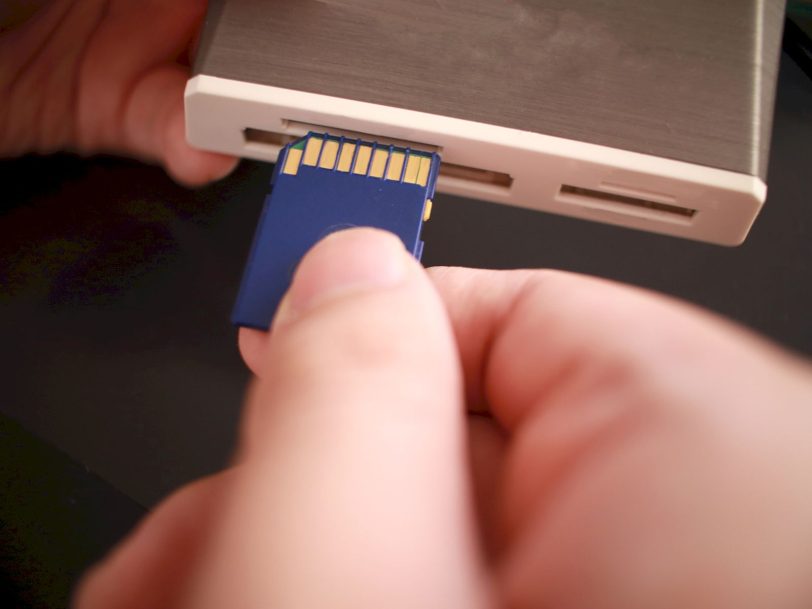What are the SD card types?

You may be very used to using it in your daily life. The SD card is one of the simplest and most convenient storage devices available today. Want to know everything about SD card features and variants? In this article, we explain what exactly an SD card is, what is hidden behind the acronyms UHS, SDHC or SDXC, and what are the main features you need to know, among others.
What is SD card?
SD card is an external storage medium designed for devices such as phones, computers, drones or cameras. It is one of the most popular formats in its field. The original standard was developed by three technology companies, SanDisk, Panasonic, and Toshiba. It was released in 1999 as SD. You should know that the abbreviation of Secure Digital is hidden behind it.
Then two minor variants appeared. The standard SD card measures 32 x 24 millimeters, while the miniSD card measures 21.5 x 20 millimeters. To these two we must add the microSD, which is the smallest with only 15 x 11 millimeters. The least popular of the three is miniSD.
SD card properties
The SD card has some key features worth highlighting. For example, it has a system that allows you to protect the content stored in the card with a password. This can be up to 16 bytes and is usually implemented by the user.
In addition, some manufacturers have released SD with Wi-Fi connection or integrated USB connector. In 2006, a company called A-DATA released a card with an integrated display. Finally, we need to tell you about one of the most important features of SD cards. We refer to its physical write-protection, which prevents accidental insertion of data. Only standard SD card and adapters of the same size contain this key.
SD card types
So far we have given you some background explaining what an SD card is, what variants are available and what are its key features. Now it’s time to focus on the different classes released based on bus speed.
What is IHS?
UHS is a term that has been used since version 3.01 of SD card. It refers to the ultra-high-speed bus that allows data to be written to and read from memory faster. In total, there were three versions until 2018, when another class began to be used. These are as follows:
- UHS-I. At a time when SD cards could only reach 25 MB/s, it could go up to 50 MB/s with UHS-I. Thanks to some of the technologies SanDisk applied, a record of up to 170 MB/s was broken. Finally, in this class, it was possible to reach 180 MB/s with MyMemory PRO.
- UHS-II. This feature came in version 4.0 of SD card. The theoretical maximum is set to 156 MB/s. However, thanks to the use of an additional pin file, speeds of up to 312 MB/s were achieved.
- UHS-III. Coming in 2017 with USH-II’s 312 MB/s mirroring capacity. It appears with the 6.0 version of the SD card.
SD Express
The names and speeds used to classify SD cards are changing in 2018. From then on, the UHS name is set aside and SD Express is used. To date, in version 8.0, a maximum bandwidth of almost 4000 MB/s has been achieved.
Types of SD cards by capacity
SDSC, SDHC, SDXC or SDUC? If you’re looking for information about SD card types, you’ve probably come across all these names. Do you want to know what they mean? Next, we uncover what lurks behind each of them.
SDSC
It is the first standard that appeared in 1999. The abbreviation stands for Secure Digital Standard Capacity. They have capacities up to 2GB and are available in any size. They can be formatted with FAT12 or FAT16 file systems.
SDHC
SDHC is Secure Digital High Capacity. It was released in 2006 and has a storage capacity of up to 32 GB. Obviously, lower storage capacities were also available. In grade 10, they offered a minimum write speed of 10MB/s. They offered support for FAT32.
SDXC
SDXC stands for Secure Digital Extended Capacity. We are facing a new generation that supports up to 2TB of storage. In terms of capacity, it’s undoubtedly one of the biggest leaps the SD card has ever experienced. It appeared in 2009 with transfer speeds of up to 170 MB/s thanks to exFAT file system support and the UHS-I bus.
SDUC
We came to the ultra capacity format, which managed to reach 128 TB. In addition, they use the aforementioned SD Express bus, which allows for very high transfer rates.
SDIO
SDIO stands for Secure Digital Input/Output. It is a variant used not for storing data, but for compatibility with hardware components such as fingerprint readers or Bluetooth adapters. All of them can be installed in the same slot where a traditional SD card is inserted.
SD card has been with us for over 20 years. It is true that the use of cloud storage puts this type of media in second place. But SD memories still have a lot to say in industries like photography, cell phone or video recording. Users around the world use them to store videos shot with their action cameras or to save apps, games or music.